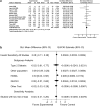Omega-3 polyunsaturated fatty acid and insulin sensitivity: a meta-analysis of randomized controlled trials
- PMID: 21959352
- PMCID: PMC5066815
- DOI: 10.1016/j.clnu.2011.08.013
Omega-3 polyunsaturated fatty acid and insulin sensitivity: a meta-analysis of randomized controlled trials
Abstract
BACKGROUND &AIM: n-3 PUFA has been shown to decrease the risk of several components of the metabolic syndrome; however, the role of n-3 PUFA on glucose metabolism is not clear. Our aim was to systematically review the effect of n-3 PUFA on IS by conducting a meta-analysis of available RCTs.
Methods: We followed the guidelines of Cochrane's review of systematic interventions. We searched MEDLINE, EMBASE, CENTRAL and clinicaltrials.gov from the beginning of each database until October 2010. Meta-analysis was performed using a random effects model to estimate a pooled SMD and the corresponding 95% CI.
Results: From 303 screened citations, 11 RCTs (n = 618) were eligible for inclusion in the analysis. In a pooled estimate, n-3 PUFA intervention had no effects on IS compared to placebo (SMD 0.08, 95% CI -0.11-0.28). Similarly, n-3 PUFA had no effects on IS in sub-group analyses (Type 2 diabetes vs. other population; QUICKI and other test subgroups). In the HOMA subgroup, n-3 PUFA was associated with a statistically significant increase in IS (SMD 0.30, CI 0.03-0.58) when compared to placebo.
Conclusion: This meta-analysis is consistent with a lack of n-3 PUFA effects on IS.
2011 Elsevier Ltd and European Society for Clinical Nutrition and Metabolism. All rights reserved.
Conflict of interest statement
The authors declare no conflict of interest.
Figures
References
-
- Psota TL, Gebauer SK, Kris-Etherton P. Dietary omega-3 fatty acid intake and cardiovascular risk. Am J Cardiol. 2006 Aug 21;98(4A):3i–18i. [Epub 2006 May 30] - PubMed
-
- Balk EM, Lichtenstein AH, Chung M, Kupelnick B, Chew P, Lau J. Effects of omega-3 fatty acids on serum markers of cardiovascular disease risk: a systematic review. Atherosclerosis. 2006 Nov;189(1):19–30. [Epub 2006 Mar 10] - PubMed
-
- Harris WS. n-3 fatty acids and serum lipoproteins: human studies. Am J Clin Nutr. 1997;65(suppl):1645S–54S. - PubMed
-
- Geleijnse JM, Giltay EJ, Grobbee DE, Donders AR, Kok FJ. Blood pressure response to fish oil supplementation: metaregression analysis of randomized trials. J Hypertens. 2002 Aug;20(8):1493–9. - PubMed
-
- Buckley JD, Howe PR. Anti-obesity effects of long-chain omega-3 polyunsaturated fatty acids. Obes Rev. 2009 Nov;10(6):648–59. [Epub 2009 May 12] - PubMed
Publication types
MeSH terms
Substances
Grants and funding
LinkOut - more resources
Full Text Sources
Medical




